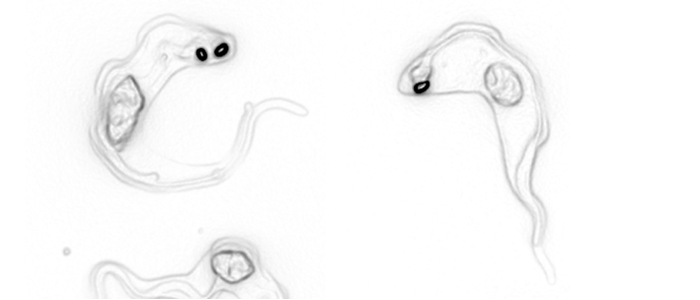Ines Subota
The most exciting thing about research is to be the first one to discover the solution to the riddles that nature has needed millennia to develop.

Ines Subota
... is a parasitologist interested in the molecular cell biology of the trypanosome life cycle. She first got in contact with trypanosomes during her studies in biology at the Ludwig-Maximilians-Universität in Munich. Her diploma thesis at the Max-Planck-Institute in Munich was an excursion into the field of biochemistry. For her doctorate she decided to work with trypanosomes again, and moved in 2007 to the Institut Pasteur in Paris with a fellowship from the Luxemburg government. In 2011 she was awarded her PhD from the Julius-Maximilians-Universität in Würzburg and directly started her postdoc in the Cell and Developmental Biology department. In the department, Ines set up the first German insectarium for the breeding of tsetse flies and their infection with trypanosome parasites. Since then, she has coordinated the organisation of the various tasks and quality control associated with the insectarium. Ines is not only passionate about her research projects but also about teaching students in practical courses and lab management.
since 2018 Postdoctoral Fellow, Physiological Chemistry, LMU Munich
2012-2018 Manager of the tsetse fly insectary, Cell and Developmental Biology, University of Würzburg
2011-2017 Postdoc, Cell and Developmental Biology, University of Würzburg
2011 Dr. rer. nat. University of Würzburg
2007-2011 Doctorate, Institut Pasteur, Paris
2006 Dipl. biol., LMU Munich
Research synopsis
My main interest from my PhD to date is the investigation of stage differentiation during the trypanosome parasite life cycle – the external signals, the molecular triggers, and the signal perception.
During my doctoral studies I discovered the role of ALBA RNA-binding proteins during stage differentiation of the parasite in the tsetse fly. I was introduced to the complex succession of life cycle stages of trypanosomes in their tsetse host, and thereby involved in several projects in the laboratory. An important structure in signal perception is the parasite flagellum, which I investigated and validated candidate proteins from a proteomic study of intact, isolated flagella.
While a postdoc in Würzburg, I established a tsetse insectary, with help from Brice Rotureau and Philippe Bastin (Institut Pasteur). Parasite infections were successfully accomplished, and we are now able to breed our own tsetse flies in the insectary. This has opened up several interesting projects for PhD students. After this work establishing tsetse infection, optimisation of parasite life microscopy, and implementation of the breeding facility, I switched my tasks to team organisation and quality management.
My main current research focus in the laboratory is the identification of the molecular nature of SIF (stumpy induction factor). In collaboration with the metabolomics core facility of the Biocenter, we aim for the stepwise purification and identification of this elusive parasite-derived factor, which is thought to limit the parasite burden in natural infections. The use of the more natural AnTat 1.1 serodeme for these experiments also allows the investigation of differences between monomorphic laboratory strains and the more natural pleomorphic cells during stage differentiation and signal perception.
Select Publications
Zimmermann, H.; Subota, I.; Batram, C.; Kramer, S.; Janzen, C.J.; Jones, N.; Engstler, M. (2017) A Quorum Sensing-independent Path to Stumpy Development in Trypanosoma brucei. Plos Pathogens; doi: 10.1371/journal.ppat.1006324
Glogger, M.; Subota, I.; Pezzarossa, A.; Denecke, A.-L.; Carrington, M.; Fenz, S.F.; Engstler, M. (2017) Facilitating trypanosome imaging. Experimental Parasitology; doi: 10.1016/ j.exppara.2017.03.010.
Glogger, M.; Stichler, S.; Subota, I.; Bertlein, S.; Spindler, M.; Tessmar, J.; Groll, J.; Engstler, M.; Fenz, S.F. (2017) Live-cell super-resolution imaging of intrinsically fast moving flagellates. Journal of Physics D: Applied Physics,50,7,074004
Dejung, M.; Subota, I.; Bucerius, F.; Dindar, D.; Freiwald, A.; Engstler, M.; Boshart, M.; Butter, F.; Janzen, C.J. (2016) Quantitative Proteomics Uncovers Novel Factors Involved in Developmental Differentiation of Trypanosoma brucei. Plos Pathogens; doi: 10.1371/journal.ppat.1005439
Subota, I.*; Julkowska, D.*; Vincensini, L.; Reeg, N.; Buisson, J.; Blisnick, T.; Huet, D.; Perrot, S.; Santi-Rocca, J.; Duchateau, M; et. al.; Bastin, P. (2014) Proteomic analysis of intact flagella of procyclic Trypanosoma brucei cells identifies novel flagellar proteins with unique sub-localisation and dynamics. Molecular and Cellular Proteomics; doi: 10.1074/mcp.M113.033357
Rotureau, B.; Subota, I.; Buisson, J.; Bastin, P. (2012) A new asymmetric division explains the continuous production of infective trypanosomes in the salivary glands of the tsetse fly. Development; doi: 10.1242/dev.072611
Subota, I.; Rotureau, B.; Blisnick, T.; Ngwabyt, S.; Durand-Dubief, M.; Engstler, M.; Bastin, P. (2011) ALBA proteins are stage regulated during trypanosome development in the tsetse fly and participate in differentiation. Molecular Biology of the Cell; doi: 10.1091/mbc.E11-06-0511








